Auditing LLC Company (landlease group) - ACCT20075 Assessment Task 2
VerifiedAdded on 2023/06/07
|14
|3325
|288
AI Summary
This report discusses the auditing process of LLC Company (landlease group) for ACCT20075 Assessment Task 2. It covers materiality, review of draft notes and disclosures, preliminary analytical review, analysis of cash flow statement, and more.
Contribute Materials
Your contribution can guide someone’s learning journey. Share your
documents today.
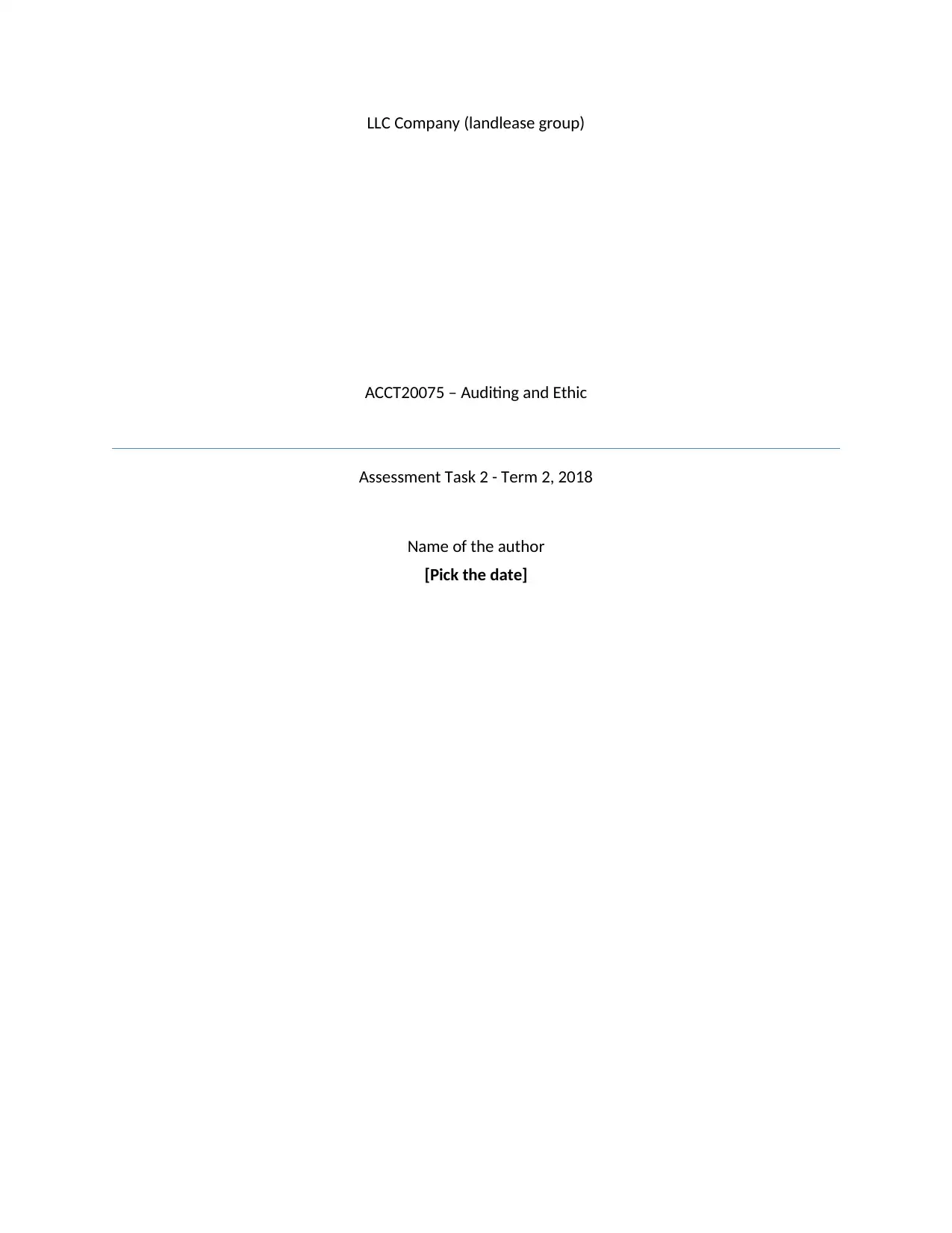
LLC Company (landlease group)
ACCT20075 – Auditing and Ethic
Assessment Task 2 - Term 2, 2018
Name of the author
[Pick the date]
ACCT20075 – Auditing and Ethic
Assessment Task 2 - Term 2, 2018
Name of the author
[Pick the date]
Secure Best Marks with AI Grader
Need help grading? Try our AI Grader for instant feedback on your assignments.
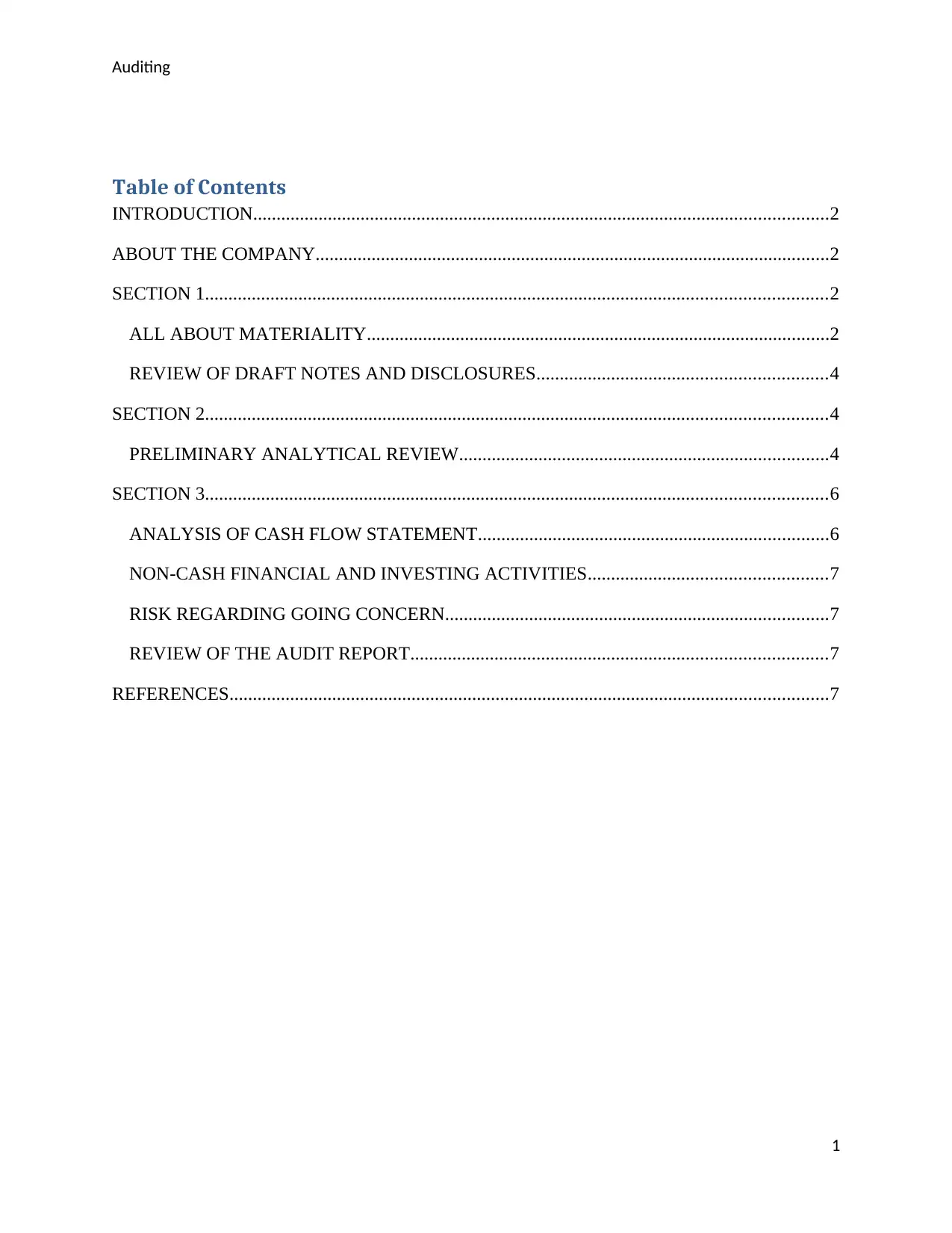
Auditing
Table of Contents
INTRODUCTION...........................................................................................................................2
ABOUT THE COMPANY..............................................................................................................2
SECTION 1.....................................................................................................................................2
ALL ABOUT MATERIALITY...................................................................................................2
REVIEW OF DRAFT NOTES AND DISCLOSURES..............................................................4
SECTION 2.....................................................................................................................................4
PRELIMINARY ANALYTICAL REVIEW...............................................................................4
SECTION 3.....................................................................................................................................6
ANALYSIS OF CASH FLOW STATEMENT...........................................................................6
NON-CASH FINANCIAL AND INVESTING ACTIVITIES...................................................7
RISK REGARDING GOING CONCERN..................................................................................7
REVIEW OF THE AUDIT REPORT.........................................................................................7
REFERENCES................................................................................................................................7
1
Table of Contents
INTRODUCTION...........................................................................................................................2
ABOUT THE COMPANY..............................................................................................................2
SECTION 1.....................................................................................................................................2
ALL ABOUT MATERIALITY...................................................................................................2
REVIEW OF DRAFT NOTES AND DISCLOSURES..............................................................4
SECTION 2.....................................................................................................................................4
PRELIMINARY ANALYTICAL REVIEW...............................................................................4
SECTION 3.....................................................................................................................................6
ANALYSIS OF CASH FLOW STATEMENT...........................................................................6
NON-CASH FINANCIAL AND INVESTING ACTIVITIES...................................................7
RISK REGARDING GOING CONCERN..................................................................................7
REVIEW OF THE AUDIT REPORT.........................................................................................7
REFERENCES................................................................................................................................7
1
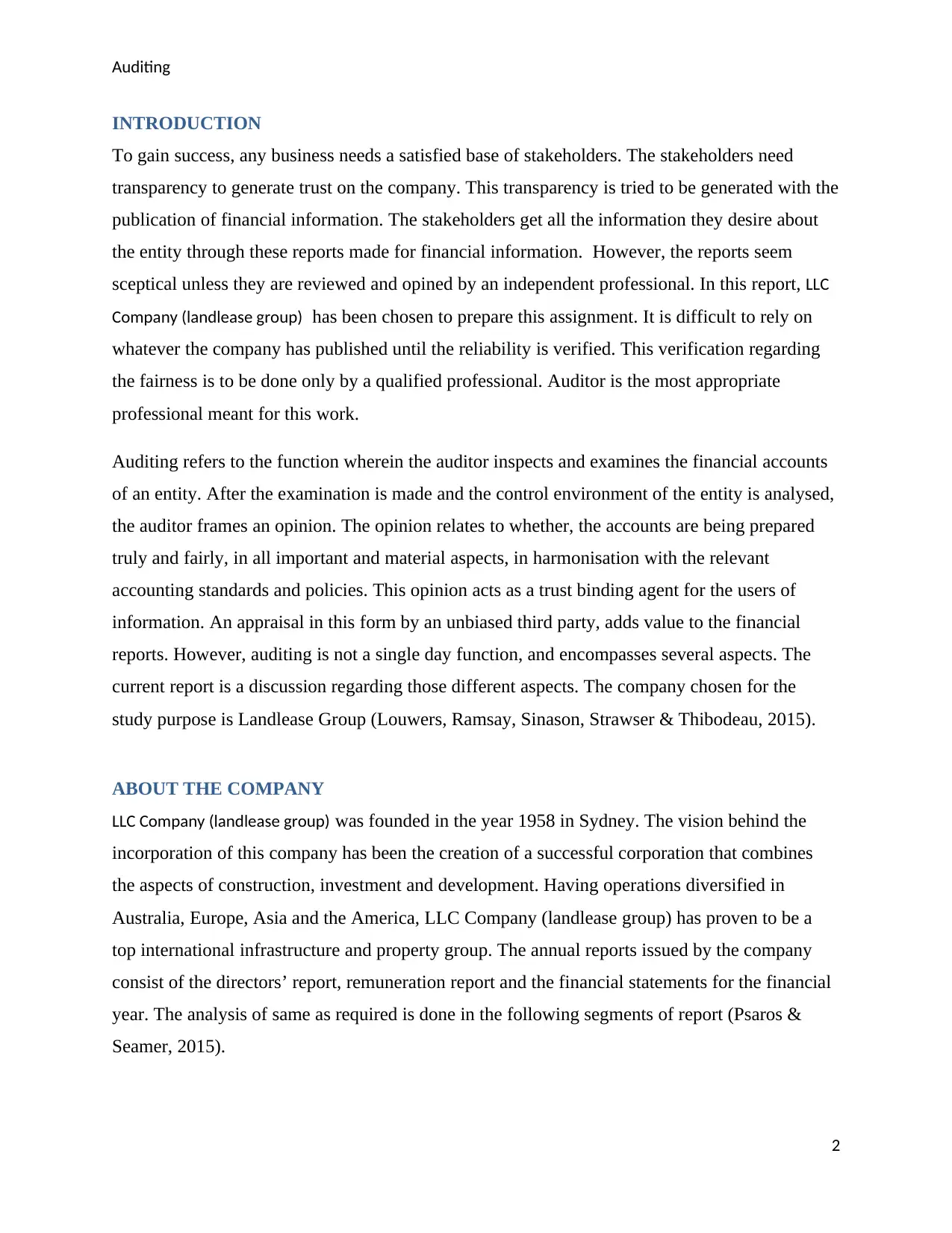
Auditing
INTRODUCTION
To gain success, any business needs a satisfied base of stakeholders. The stakeholders need
transparency to generate trust on the company. This transparency is tried to be generated with the
publication of financial information. The stakeholders get all the information they desire about
the entity through these reports made for financial information. However, the reports seem
sceptical unless they are reviewed and opined by an independent professional. In this report, LLC
Company (landlease group) has been chosen to prepare this assignment. It is difficult to rely on
whatever the company has published until the reliability is verified. This verification regarding
the fairness is to be done only by a qualified professional. Auditor is the most appropriate
professional meant for this work.
Auditing refers to the function wherein the auditor inspects and examines the financial accounts
of an entity. After the examination is made and the control environment of the entity is analysed,
the auditor frames an opinion. The opinion relates to whether, the accounts are being prepared
truly and fairly, in all important and material aspects, in harmonisation with the relevant
accounting standards and policies. This opinion acts as a trust binding agent for the users of
information. An appraisal in this form by an unbiased third party, adds value to the financial
reports. However, auditing is not a single day function, and encompasses several aspects. The
current report is a discussion regarding those different aspects. The company chosen for the
study purpose is Landlease Group (Louwers, Ramsay, Sinason, Strawser & Thibodeau, 2015).
ABOUT THE COMPANY
LLC Company (landlease group) was founded in the year 1958 in Sydney. The vision behind the
incorporation of this company has been the creation of a successful corporation that combines
the aspects of construction, investment and development. Having operations diversified in
Australia, Europe, Asia and the America, LLC Company (landlease group) has proven to be a
top international infrastructure and property group. The annual reports issued by the company
consist of the directors’ report, remuneration report and the financial statements for the financial
year. The analysis of same as required is done in the following segments of report (Psaros &
Seamer, 2015).
2
INTRODUCTION
To gain success, any business needs a satisfied base of stakeholders. The stakeholders need
transparency to generate trust on the company. This transparency is tried to be generated with the
publication of financial information. The stakeholders get all the information they desire about
the entity through these reports made for financial information. However, the reports seem
sceptical unless they are reviewed and opined by an independent professional. In this report, LLC
Company (landlease group) has been chosen to prepare this assignment. It is difficult to rely on
whatever the company has published until the reliability is verified. This verification regarding
the fairness is to be done only by a qualified professional. Auditor is the most appropriate
professional meant for this work.
Auditing refers to the function wherein the auditor inspects and examines the financial accounts
of an entity. After the examination is made and the control environment of the entity is analysed,
the auditor frames an opinion. The opinion relates to whether, the accounts are being prepared
truly and fairly, in all important and material aspects, in harmonisation with the relevant
accounting standards and policies. This opinion acts as a trust binding agent for the users of
information. An appraisal in this form by an unbiased third party, adds value to the financial
reports. However, auditing is not a single day function, and encompasses several aspects. The
current report is a discussion regarding those different aspects. The company chosen for the
study purpose is Landlease Group (Louwers, Ramsay, Sinason, Strawser & Thibodeau, 2015).
ABOUT THE COMPANY
LLC Company (landlease group) was founded in the year 1958 in Sydney. The vision behind the
incorporation of this company has been the creation of a successful corporation that combines
the aspects of construction, investment and development. Having operations diversified in
Australia, Europe, Asia and the America, LLC Company (landlease group) has proven to be a
top international infrastructure and property group. The annual reports issued by the company
consist of the directors’ report, remuneration report and the financial statements for the financial
year. The analysis of same as required is done in the following segments of report (Psaros &
Seamer, 2015).
2
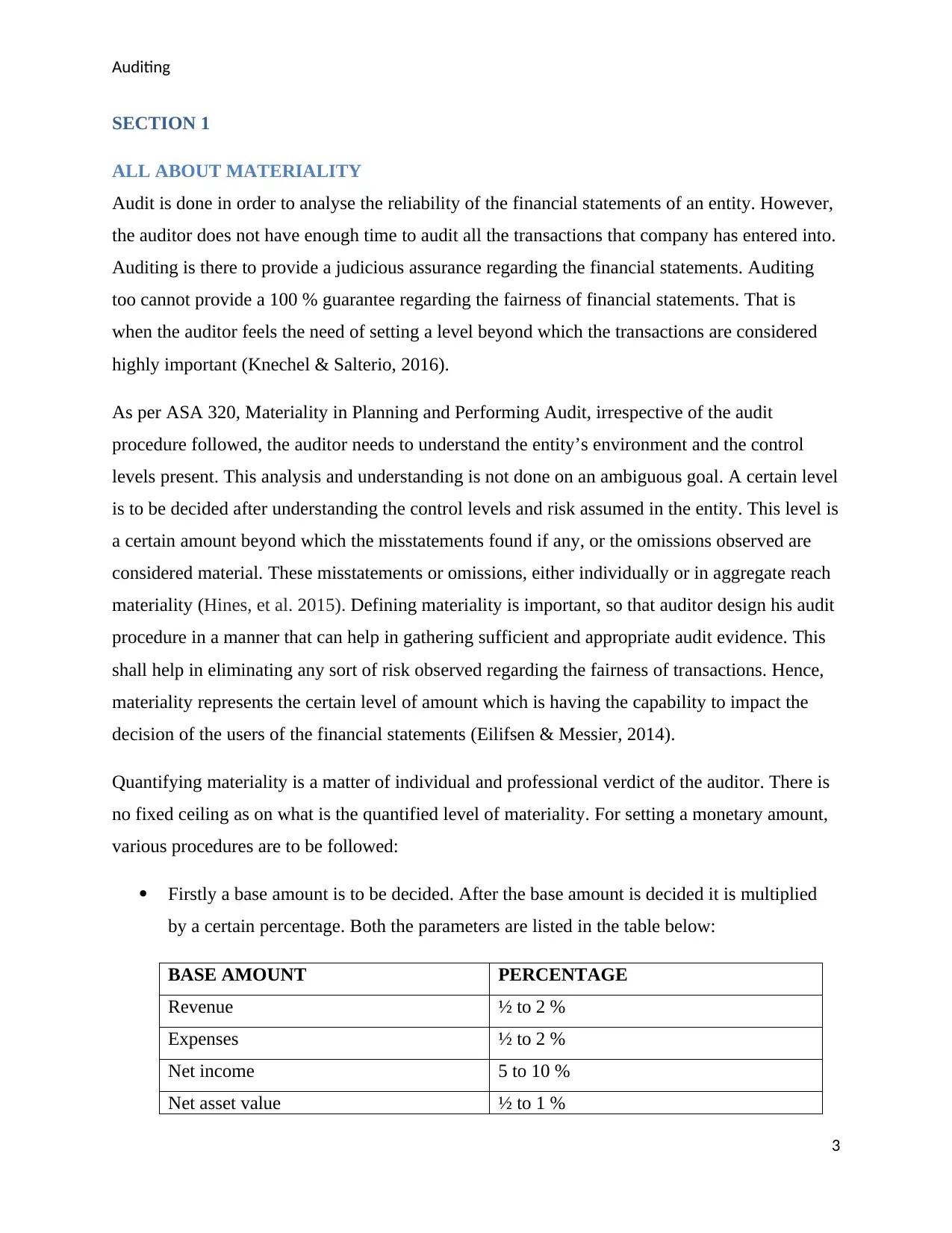
Auditing
SECTION 1
ALL ABOUT MATERIALITY
Audit is done in order to analyse the reliability of the financial statements of an entity. However,
the auditor does not have enough time to audit all the transactions that company has entered into.
Auditing is there to provide a judicious assurance regarding the financial statements. Auditing
too cannot provide a 100 % guarantee regarding the fairness of financial statements. That is
when the auditor feels the need of setting a level beyond which the transactions are considered
highly important (Knechel & Salterio, 2016).
As per ASA 320, Materiality in Planning and Performing Audit, irrespective of the audit
procedure followed, the auditor needs to understand the entity’s environment and the control
levels present. This analysis and understanding is not done on an ambiguous goal. A certain level
is to be decided after understanding the control levels and risk assumed in the entity. This level is
a certain amount beyond which the misstatements found if any, or the omissions observed are
considered material. These misstatements or omissions, either individually or in aggregate reach
materiality (Hines, et al. 2015). Defining materiality is important, so that auditor design his audit
procedure in a manner that can help in gathering sufficient and appropriate audit evidence. This
shall help in eliminating any sort of risk observed regarding the fairness of transactions. Hence,
materiality represents the certain level of amount which is having the capability to impact the
decision of the users of the financial statements (Eilifsen & Messier, 2014).
Quantifying materiality is a matter of individual and professional verdict of the auditor. There is
no fixed ceiling as on what is the quantified level of materiality. For setting a monetary amount,
various procedures are to be followed:
Firstly a base amount is to be decided. After the base amount is decided it is multiplied
by a certain percentage. Both the parameters are listed in the table below:
BASE AMOUNT PERCENTAGE
Revenue ½ to 2 %
Expenses ½ to 2 %
Net income 5 to 10 %
Net asset value ½ to 1 %
3
SECTION 1
ALL ABOUT MATERIALITY
Audit is done in order to analyse the reliability of the financial statements of an entity. However,
the auditor does not have enough time to audit all the transactions that company has entered into.
Auditing is there to provide a judicious assurance regarding the financial statements. Auditing
too cannot provide a 100 % guarantee regarding the fairness of financial statements. That is
when the auditor feels the need of setting a level beyond which the transactions are considered
highly important (Knechel & Salterio, 2016).
As per ASA 320, Materiality in Planning and Performing Audit, irrespective of the audit
procedure followed, the auditor needs to understand the entity’s environment and the control
levels present. This analysis and understanding is not done on an ambiguous goal. A certain level
is to be decided after understanding the control levels and risk assumed in the entity. This level is
a certain amount beyond which the misstatements found if any, or the omissions observed are
considered material. These misstatements or omissions, either individually or in aggregate reach
materiality (Hines, et al. 2015). Defining materiality is important, so that auditor design his audit
procedure in a manner that can help in gathering sufficient and appropriate audit evidence. This
shall help in eliminating any sort of risk observed regarding the fairness of transactions. Hence,
materiality represents the certain level of amount which is having the capability to impact the
decision of the users of the financial statements (Eilifsen & Messier, 2014).
Quantifying materiality is a matter of individual and professional verdict of the auditor. There is
no fixed ceiling as on what is the quantified level of materiality. For setting a monetary amount,
various procedures are to be followed:
Firstly a base amount is to be decided. After the base amount is decided it is multiplied
by a certain percentage. Both the parameters are listed in the table below:
BASE AMOUNT PERCENTAGE
Revenue ½ to 2 %
Expenses ½ to 2 %
Net income 5 to 10 %
Net asset value ½ to 1 %
3
Secure Best Marks with AI Grader
Need help grading? Try our AI Grader for instant feedback on your assignments.
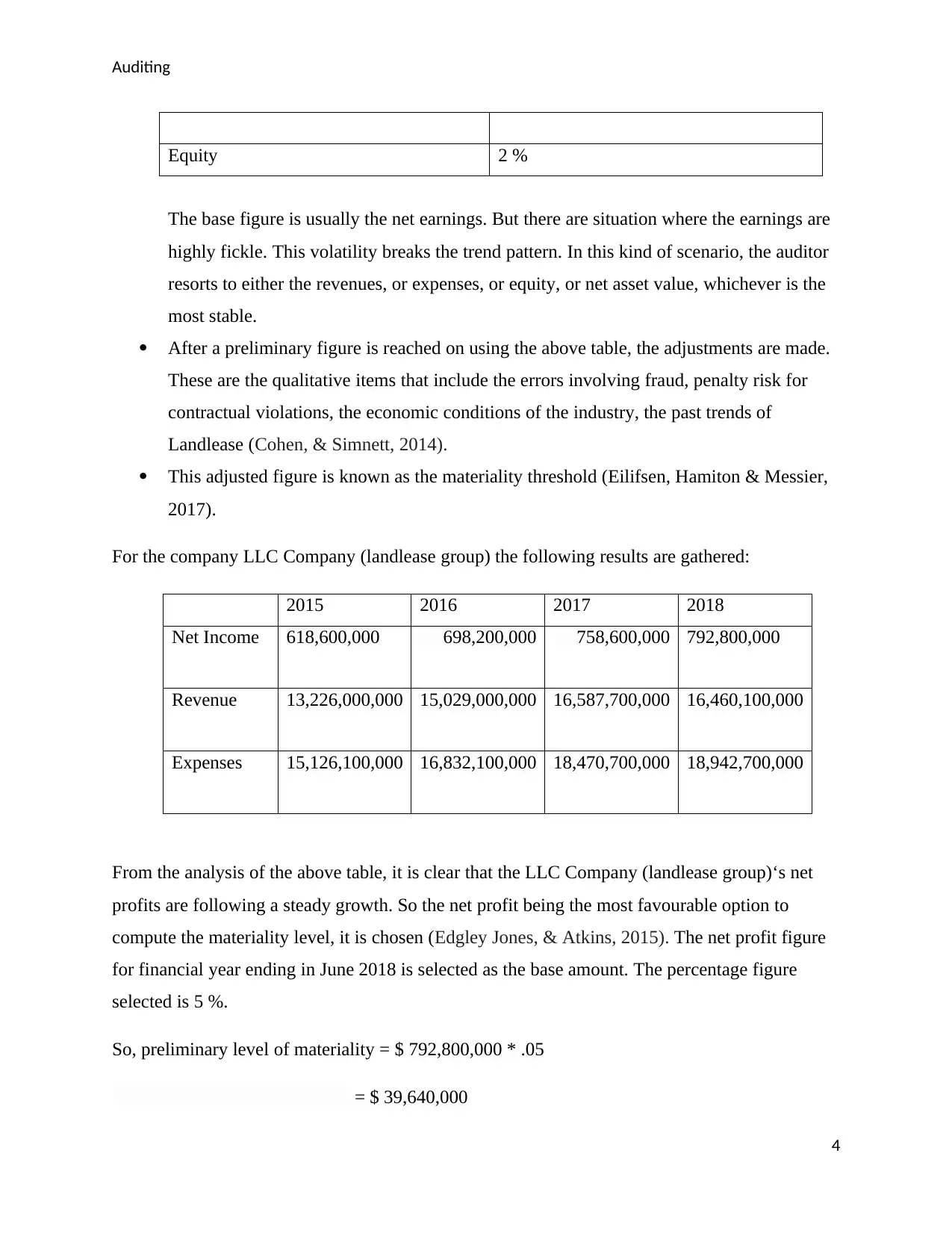
Auditing
Equity 2 %
The base figure is usually the net earnings. But there are situation where the earnings are
highly fickle. This volatility breaks the trend pattern. In this kind of scenario, the auditor
resorts to either the revenues, or expenses, or equity, or net asset value, whichever is the
most stable.
After a preliminary figure is reached on using the above table, the adjustments are made.
These are the qualitative items that include the errors involving fraud, penalty risk for
contractual violations, the economic conditions of the industry, the past trends of
Landlease (Cohen, & Simnett, 2014).
This adjusted figure is known as the materiality threshold (Eilifsen, Hamiton & Messier,
2017).
For the company LLC Company (landlease group) the following results are gathered:
2015 2016 2017 2018
Net Income 618,600,000 698,200,000 758,600,000 792,800,000
Revenue 13,226,000,000 15,029,000,000 16,587,700,000 16,460,100,000
Expenses 15,126,100,000 16,832,100,000 18,470,700,000 18,942,700,000
From the analysis of the above table, it is clear that the LLC Company (landlease group)‘s net
profits are following a steady growth. So the net profit being the most favourable option to
compute the materiality level, it is chosen (Edgley Jones, & Atkins, 2015). The net profit figure
for financial year ending in June 2018 is selected as the base amount. The percentage figure
selected is 5 %.
So, preliminary level of materiality = $ 792,800,000 * .05
= $ 39,640,000
4
Equity 2 %
The base figure is usually the net earnings. But there are situation where the earnings are
highly fickle. This volatility breaks the trend pattern. In this kind of scenario, the auditor
resorts to either the revenues, or expenses, or equity, or net asset value, whichever is the
most stable.
After a preliminary figure is reached on using the above table, the adjustments are made.
These are the qualitative items that include the errors involving fraud, penalty risk for
contractual violations, the economic conditions of the industry, the past trends of
Landlease (Cohen, & Simnett, 2014).
This adjusted figure is known as the materiality threshold (Eilifsen, Hamiton & Messier,
2017).
For the company LLC Company (landlease group) the following results are gathered:
2015 2016 2017 2018
Net Income 618,600,000 698,200,000 758,600,000 792,800,000
Revenue 13,226,000,000 15,029,000,000 16,587,700,000 16,460,100,000
Expenses 15,126,100,000 16,832,100,000 18,470,700,000 18,942,700,000
From the analysis of the above table, it is clear that the LLC Company (landlease group)‘s net
profits are following a steady growth. So the net profit being the most favourable option to
compute the materiality level, it is chosen (Edgley Jones, & Atkins, 2015). The net profit figure
for financial year ending in June 2018 is selected as the base amount. The percentage figure
selected is 5 %.
So, preliminary level of materiality = $ 792,800,000 * .05
= $ 39,640,000
4
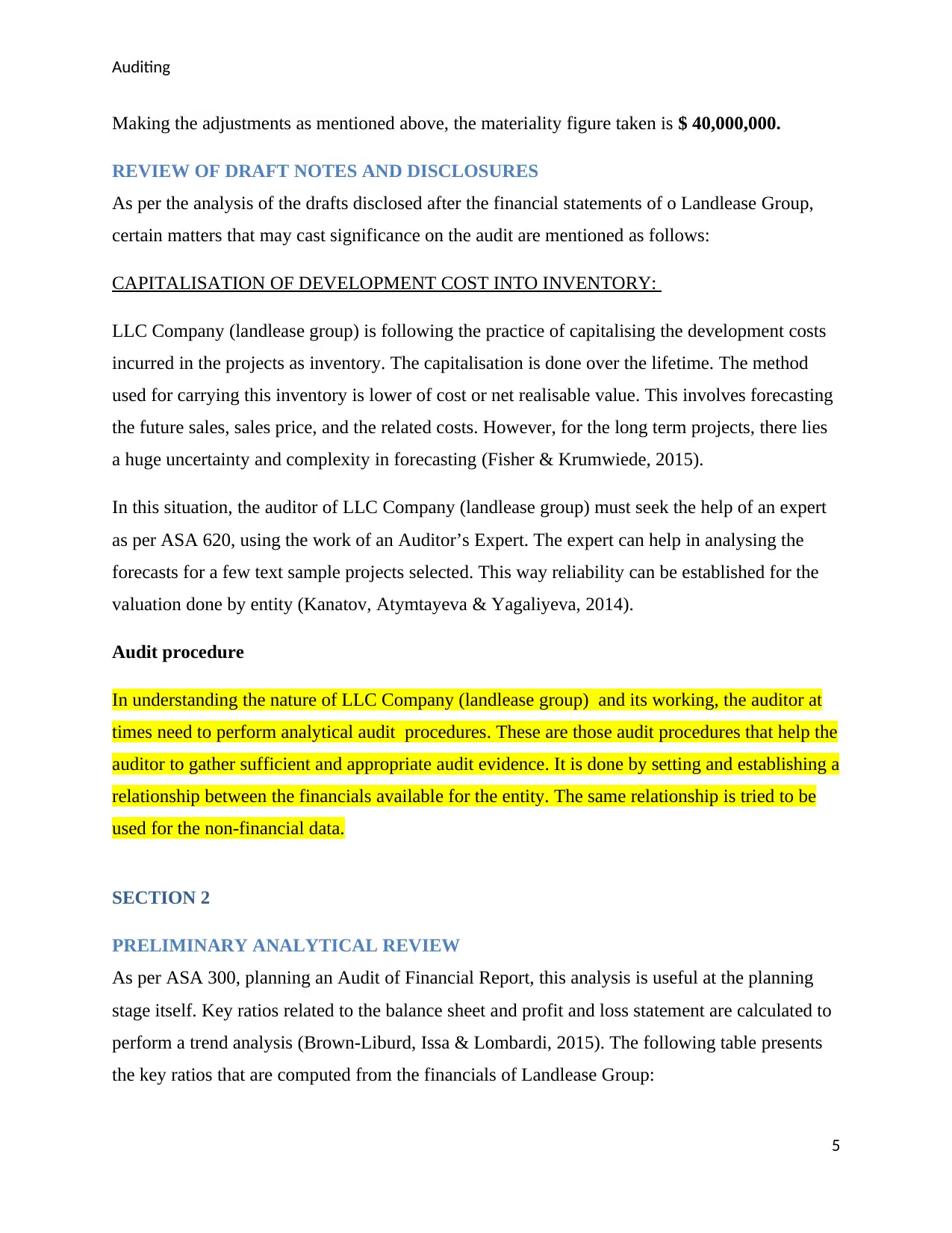
Auditing
Making the adjustments as mentioned above, the materiality figure taken is $ 40,000,000.
REVIEW OF DRAFT NOTES AND DISCLOSURES
As per the analysis of the drafts disclosed after the financial statements of o Landlease Group,
certain matters that may cast significance on the audit are mentioned as follows:
CAPITALISATION OF DEVELOPMENT COST INTO INVENTORY:
LLC Company (landlease group) is following the practice of capitalising the development costs
incurred in the projects as inventory. The capitalisation is done over the lifetime. The method
used for carrying this inventory is lower of cost or net realisable value. This involves forecasting
the future sales, sales price, and the related costs. However, for the long term projects, there lies
a huge uncertainty and complexity in forecasting (Fisher & Krumwiede, 2015).
In this situation, the auditor of LLC Company (landlease group) must seek the help of an expert
as per ASA 620, using the work of an Auditor’s Expert. The expert can help in analysing the
forecasts for a few text sample projects selected. This way reliability can be established for the
valuation done by entity (Kanatov, Atymtayeva & Yagaliyeva, 2014).
Audit procedure
In understanding the nature of LLC Company (landlease group) and its working, the auditor at
times need to perform analytical audit procedures. These are those audit procedures that help the
auditor to gather sufficient and appropriate audit evidence. It is done by setting and establishing a
relationship between the financials available for the entity. The same relationship is tried to be
used for the non-financial data.
SECTION 2
PRELIMINARY ANALYTICAL REVIEW
As per ASA 300, planning an Audit of Financial Report, this analysis is useful at the planning
stage itself. Key ratios related to the balance sheet and profit and loss statement are calculated to
perform a trend analysis (Brown-Liburd, Issa & Lombardi, 2015). The following table presents
the key ratios that are computed from the financials of Landlease Group:
5
Making the adjustments as mentioned above, the materiality figure taken is $ 40,000,000.
REVIEW OF DRAFT NOTES AND DISCLOSURES
As per the analysis of the drafts disclosed after the financial statements of o Landlease Group,
certain matters that may cast significance on the audit are mentioned as follows:
CAPITALISATION OF DEVELOPMENT COST INTO INVENTORY:
LLC Company (landlease group) is following the practice of capitalising the development costs
incurred in the projects as inventory. The capitalisation is done over the lifetime. The method
used for carrying this inventory is lower of cost or net realisable value. This involves forecasting
the future sales, sales price, and the related costs. However, for the long term projects, there lies
a huge uncertainty and complexity in forecasting (Fisher & Krumwiede, 2015).
In this situation, the auditor of LLC Company (landlease group) must seek the help of an expert
as per ASA 620, using the work of an Auditor’s Expert. The expert can help in analysing the
forecasts for a few text sample projects selected. This way reliability can be established for the
valuation done by entity (Kanatov, Atymtayeva & Yagaliyeva, 2014).
Audit procedure
In understanding the nature of LLC Company (landlease group) and its working, the auditor at
times need to perform analytical audit procedures. These are those audit procedures that help the
auditor to gather sufficient and appropriate audit evidence. It is done by setting and establishing a
relationship between the financials available for the entity. The same relationship is tried to be
used for the non-financial data.
SECTION 2
PRELIMINARY ANALYTICAL REVIEW
As per ASA 300, planning an Audit of Financial Report, this analysis is useful at the planning
stage itself. Key ratios related to the balance sheet and profit and loss statement are calculated to
perform a trend analysis (Brown-Liburd, Issa & Lombardi, 2015). The following table presents
the key ratios that are computed from the financials of Landlease Group:
5
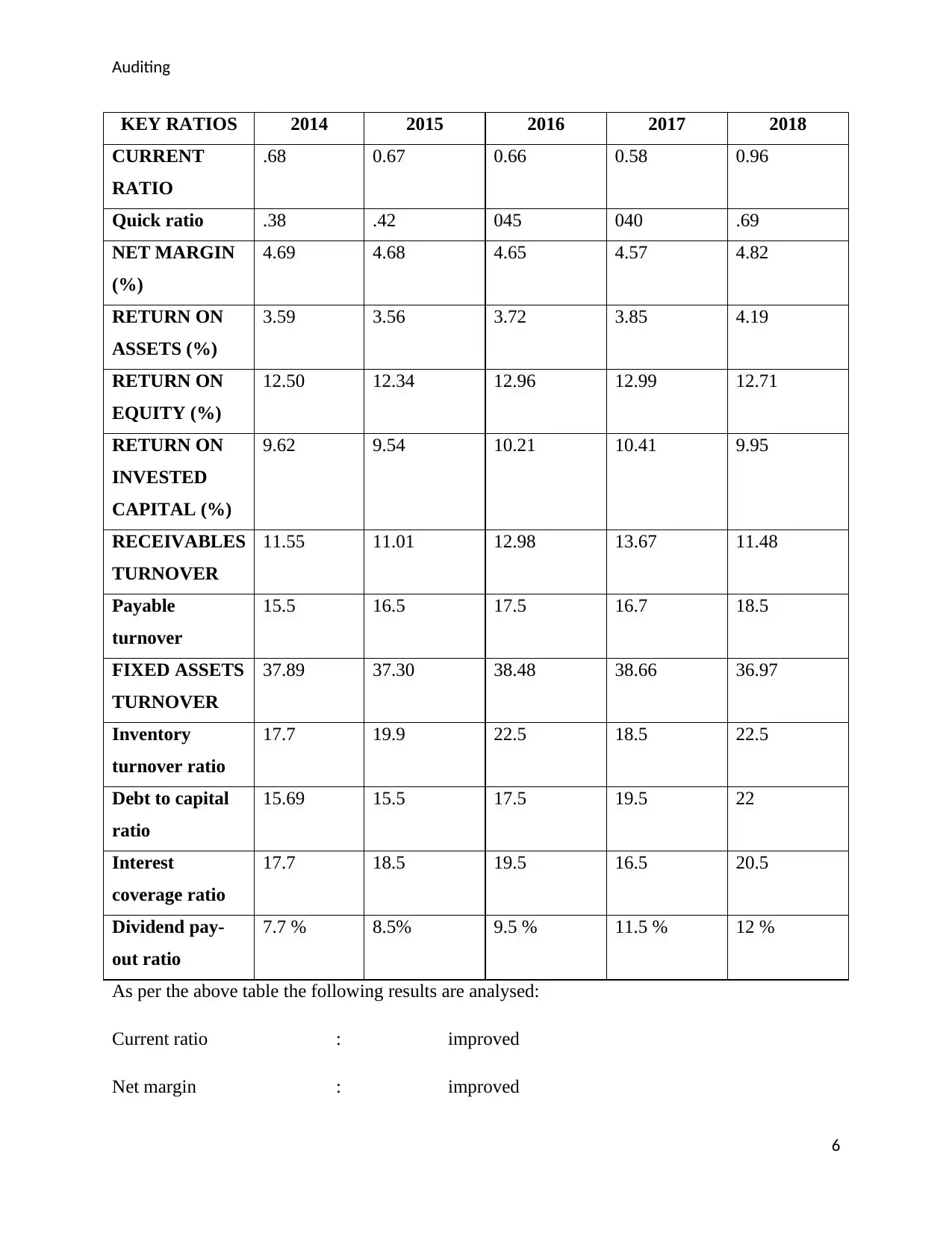
Auditing
KEY RATIOS 2014 2015 2016 2017 2018
CURRENT
RATIO
.68 0.67 0.66 0.58 0.96
Quick ratio .38 .42 045 040 .69
NET MARGIN
(%)
4.69 4.68 4.65 4.57 4.82
RETURN ON
ASSETS (%)
3.59 3.56 3.72 3.85 4.19
RETURN ON
EQUITY (%)
12.50 12.34 12.96 12.99 12.71
RETURN ON
INVESTED
CAPITAL (%)
9.62 9.54 10.21 10.41 9.95
RECEIVABLES
TURNOVER
11.55 11.01 12.98 13.67 11.48
Payable
turnover
15.5 16.5 17.5 16.7 18.5
FIXED ASSETS
TURNOVER
37.89 37.30 38.48 38.66 36.97
Inventory
turnover ratio
17.7 19.9 22.5 18.5 22.5
Debt to capital
ratio
15.69 15.5 17.5 19.5 22
Interest
coverage ratio
17.7 18.5 19.5 16.5 20.5
Dividend pay-
out ratio
7.7 % 8.5% 9.5 % 11.5 % 12 %
As per the above table the following results are analysed:
Current ratio : improved
Net margin : improved
6
KEY RATIOS 2014 2015 2016 2017 2018
CURRENT
RATIO
.68 0.67 0.66 0.58 0.96
Quick ratio .38 .42 045 040 .69
NET MARGIN
(%)
4.69 4.68 4.65 4.57 4.82
RETURN ON
ASSETS (%)
3.59 3.56 3.72 3.85 4.19
RETURN ON
EQUITY (%)
12.50 12.34 12.96 12.99 12.71
RETURN ON
INVESTED
CAPITAL (%)
9.62 9.54 10.21 10.41 9.95
RECEIVABLES
TURNOVER
11.55 11.01 12.98 13.67 11.48
Payable
turnover
15.5 16.5 17.5 16.7 18.5
FIXED ASSETS
TURNOVER
37.89 37.30 38.48 38.66 36.97
Inventory
turnover ratio
17.7 19.9 22.5 18.5 22.5
Debt to capital
ratio
15.69 15.5 17.5 19.5 22
Interest
coverage ratio
17.7 18.5 19.5 16.5 20.5
Dividend pay-
out ratio
7.7 % 8.5% 9.5 % 11.5 % 12 %
As per the above table the following results are analysed:
Current ratio : improved
Net margin : improved
6
Paraphrase This Document
Need a fresh take? Get an instant paraphrase of this document with our AI Paraphraser

Auditing
Return on assets : improved
Return on equity : declined
Return on invested capital : declined
Receivables turnover : declined
Fixed assets turnover : declined
Debt to capital ratio : Improved
Dividend pay-out ratio : Improved
The trend of the data of LLC Company (landlease group) set by these ratios generates certain
doubts. These are expressed in terms of the risk areas. The certain management assertions that
are considered in risk are also determined.
Audit procedure
The audit procedure in LLC Company (landlease group) is required to be followed to remove the
uncertainty and reach a conclusion is mentioned in the table below (Edgley, Jones, & Atkins,
2015).
KEY RISK AREA AUDIT ASSERTION AUDIT PROCEDURE
FIXED ASSETS Valuation The fixed asset turnover ratio
of LLC Company (landlease
group) has declined whereas
the return on assets has
improved. This may be due
to the improper valuation of
the fixed assets because the
overall earnings and revenues
both have shown a rise
(Christensen,., Glover, &
Wood, 2012). This may be
reduced by the auditor by
7
Return on assets : improved
Return on equity : declined
Return on invested capital : declined
Receivables turnover : declined
Fixed assets turnover : declined
Debt to capital ratio : Improved
Dividend pay-out ratio : Improved
The trend of the data of LLC Company (landlease group) set by these ratios generates certain
doubts. These are expressed in terms of the risk areas. The certain management assertions that
are considered in risk are also determined.
Audit procedure
The audit procedure in LLC Company (landlease group) is required to be followed to remove the
uncertainty and reach a conclusion is mentioned in the table below (Edgley, Jones, & Atkins,
2015).
KEY RISK AREA AUDIT ASSERTION AUDIT PROCEDURE
FIXED ASSETS Valuation The fixed asset turnover ratio
of LLC Company (landlease
group) has declined whereas
the return on assets has
improved. This may be due
to the improper valuation of
the fixed assets because the
overall earnings and revenues
both have shown a rise
(Christensen,., Glover, &
Wood, 2012). This may be
reduced by the auditor by
7

Auditing
physically verifying the
condition of the assets and
taking the help of a valuation
professional to correctly
value them.
TRADE RECEIVABLES Rights and Obligations There is a risk that the
receivables shown in the
financial report are not even
the receivables. They may be
a chance that any settled
customer is shown as a non-
settled debtor. This calls for
cash embezzlement. To
resolve this and reduce risk,
the auditor should go for
external confirmation. He
must call for balance
confirmation from the
debtors directly.
SALES OR TURNOVER Occurrence There is a doubt regarding
the figure of revenue present
in the books of in Landlease
Group. The revenue has risen
but all the turnover ratios
have shown a decline. This
risk has to be reduced by
cross checking the inventory
register with the debtor
register and cash book. The
credit and cash sales need to
match with the inventory
8
physically verifying the
condition of the assets and
taking the help of a valuation
professional to correctly
value them.
TRADE RECEIVABLES Rights and Obligations There is a risk that the
receivables shown in the
financial report are not even
the receivables. They may be
a chance that any settled
customer is shown as a non-
settled debtor. This calls for
cash embezzlement. To
resolve this and reduce risk,
the auditor should go for
external confirmation. He
must call for balance
confirmation from the
debtors directly.
SALES OR TURNOVER Occurrence There is a doubt regarding
the figure of revenue present
in the books of in Landlease
Group. The revenue has risen
but all the turnover ratios
have shown a decline. This
risk has to be reduced by
cross checking the inventory
register with the debtor
register and cash book. The
credit and cash sales need to
match with the inventory
8
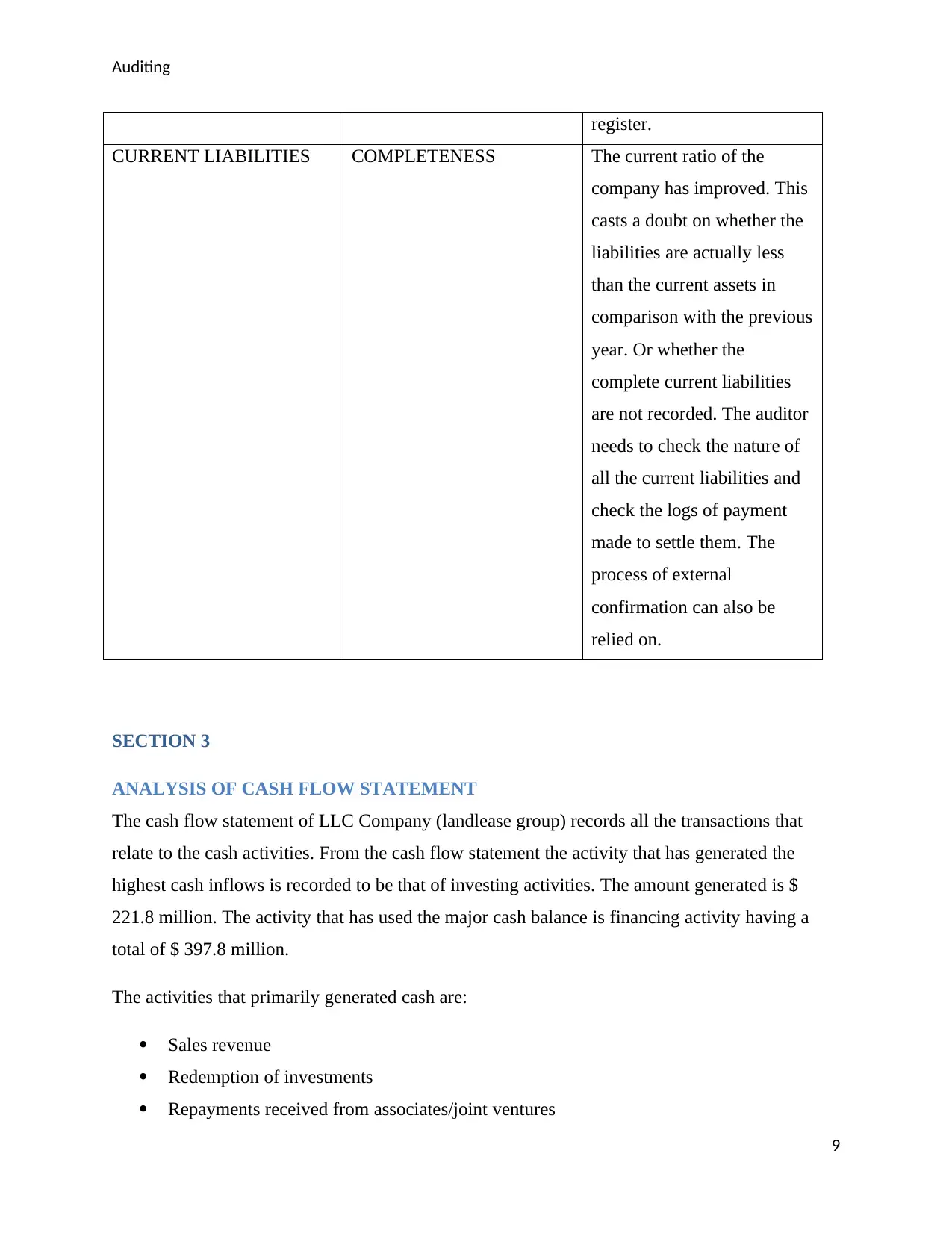
Auditing
register.
CURRENT LIABILITIES COMPLETENESS The current ratio of the
company has improved. This
casts a doubt on whether the
liabilities are actually less
than the current assets in
comparison with the previous
year. Or whether the
complete current liabilities
are not recorded. The auditor
needs to check the nature of
all the current liabilities and
check the logs of payment
made to settle them. The
process of external
confirmation can also be
relied on.
SECTION 3
ANALYSIS OF CASH FLOW STATEMENT
The cash flow statement of LLC Company (landlease group) records all the transactions that
relate to the cash activities. From the cash flow statement the activity that has generated the
highest cash inflows is recorded to be that of investing activities. The amount generated is $
221.8 million. The activity that has used the major cash balance is financing activity having a
total of $ 397.8 million.
The activities that primarily generated cash are:
Sales revenue
Redemption of investments
Repayments received from associates/joint ventures
9
register.
CURRENT LIABILITIES COMPLETENESS The current ratio of the
company has improved. This
casts a doubt on whether the
liabilities are actually less
than the current assets in
comparison with the previous
year. Or whether the
complete current liabilities
are not recorded. The auditor
needs to check the nature of
all the current liabilities and
check the logs of payment
made to settle them. The
process of external
confirmation can also be
relied on.
SECTION 3
ANALYSIS OF CASH FLOW STATEMENT
The cash flow statement of LLC Company (landlease group) records all the transactions that
relate to the cash activities. From the cash flow statement the activity that has generated the
highest cash inflows is recorded to be that of investing activities. The amount generated is $
221.8 million. The activity that has used the major cash balance is financing activity having a
total of $ 397.8 million.
The activities that primarily generated cash are:
Sales revenue
Redemption of investments
Repayments received from associates/joint ventures
9
Secure Best Marks with AI Grader
Need help grading? Try our AI Grader for instant feedback on your assignments.
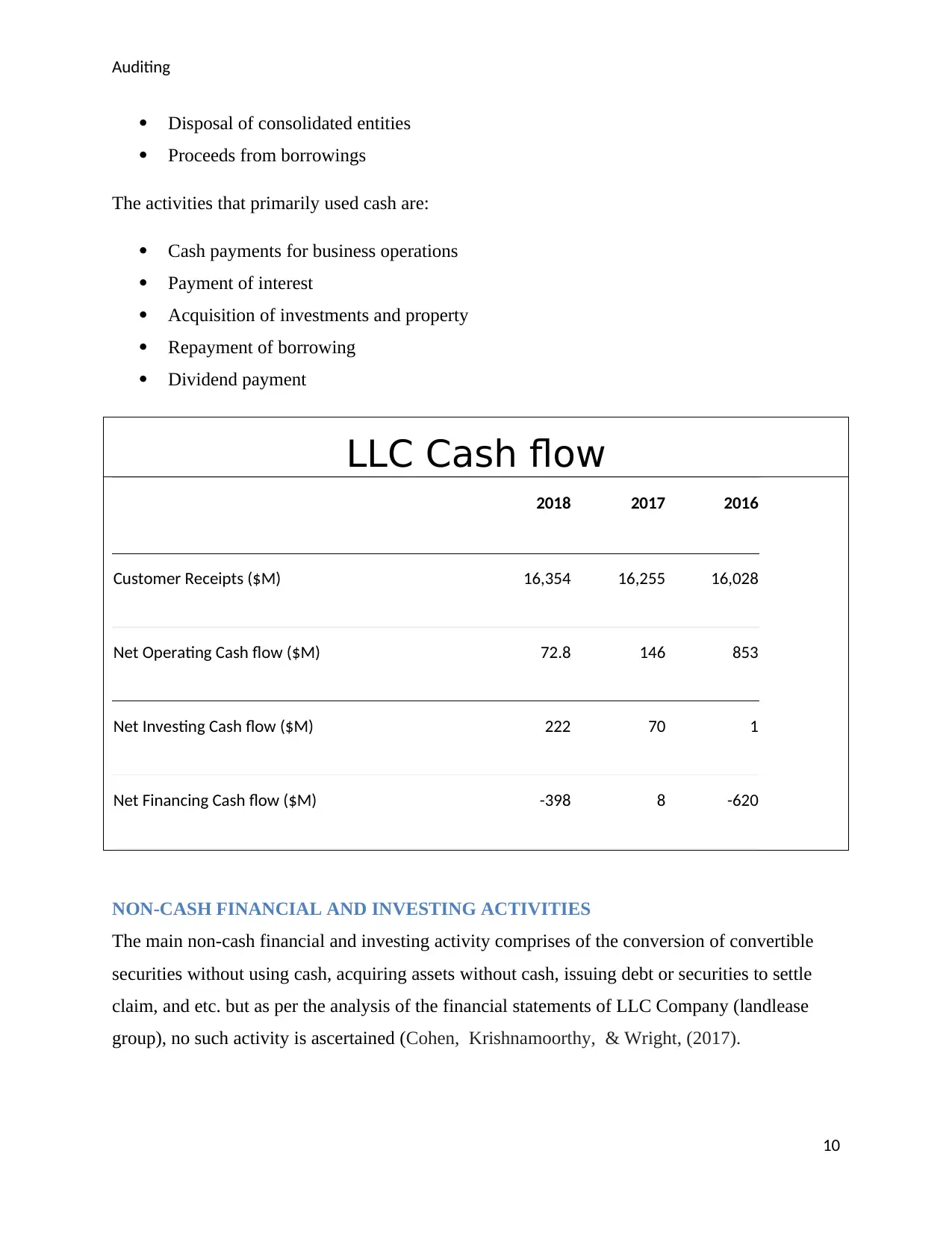
Auditing
Disposal of consolidated entities
Proceeds from borrowings
The activities that primarily used cash are:
Cash payments for business operations
Payment of interest
Acquisition of investments and property
Repayment of borrowing
Dividend payment
LLC Cash flow
2018 2017 2016
Customer Receipts ($M) 16,354 16,255 16,028
Net Operating Cash flow ($M) 72.8 146 853
Net Investing Cash flow ($M) 222 70 1
Net Financing Cash flow ($M) -398 8 -620
NON-CASH FINANCIAL AND INVESTING ACTIVITIES
The main non-cash financial and investing activity comprises of the conversion of convertible
securities without using cash, acquiring assets without cash, issuing debt or securities to settle
claim, and etc. but as per the analysis of the financial statements of LLC Company (landlease
group), no such activity is ascertained (Cohen, Krishnamoorthy, & Wright, (2017).
10
Disposal of consolidated entities
Proceeds from borrowings
The activities that primarily used cash are:
Cash payments for business operations
Payment of interest
Acquisition of investments and property
Repayment of borrowing
Dividend payment
LLC Cash flow
2018 2017 2016
Customer Receipts ($M) 16,354 16,255 16,028
Net Operating Cash flow ($M) 72.8 146 853
Net Investing Cash flow ($M) 222 70 1
Net Financing Cash flow ($M) -398 8 -620
NON-CASH FINANCIAL AND INVESTING ACTIVITIES
The main non-cash financial and investing activity comprises of the conversion of convertible
securities without using cash, acquiring assets without cash, issuing debt or securities to settle
claim, and etc. but as per the analysis of the financial statements of LLC Company (landlease
group), no such activity is ascertained (Cohen, Krishnamoorthy, & Wright, (2017).
10
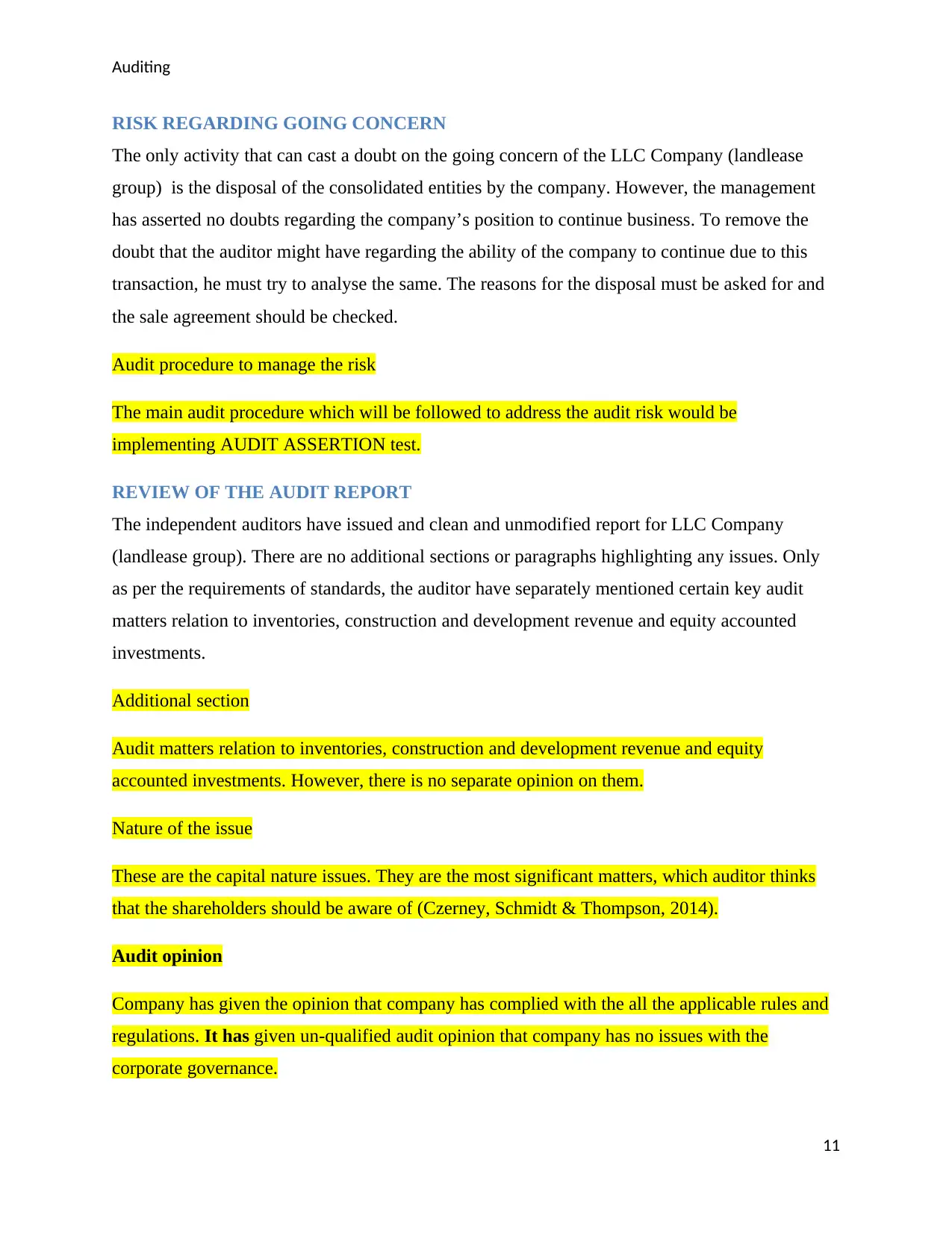
Auditing
RISK REGARDING GOING CONCERN
The only activity that can cast a doubt on the going concern of the LLC Company (landlease
group) is the disposal of the consolidated entities by the company. However, the management
has asserted no doubts regarding the company’s position to continue business. To remove the
doubt that the auditor might have regarding the ability of the company to continue due to this
transaction, he must try to analyse the same. The reasons for the disposal must be asked for and
the sale agreement should be checked.
Audit procedure to manage the risk
The main audit procedure which will be followed to address the audit risk would be
implementing AUDIT ASSERTION test.
REVIEW OF THE AUDIT REPORT
The independent auditors have issued and clean and unmodified report for LLC Company
(landlease group). There are no additional sections or paragraphs highlighting any issues. Only
as per the requirements of standards, the auditor have separately mentioned certain key audit
matters relation to inventories, construction and development revenue and equity accounted
investments.
Additional section
Audit matters relation to inventories, construction and development revenue and equity
accounted investments. However, there is no separate opinion on them.
Nature of the issue
These are the capital nature issues. They are the most significant matters, which auditor thinks
that the shareholders should be aware of (Czerney, Schmidt & Thompson, 2014).
Audit opinion
Company has given the opinion that company has complied with the all the applicable rules and
regulations. It has given un-qualified audit opinion that company has no issues with the
corporate governance.
11
RISK REGARDING GOING CONCERN
The only activity that can cast a doubt on the going concern of the LLC Company (landlease
group) is the disposal of the consolidated entities by the company. However, the management
has asserted no doubts regarding the company’s position to continue business. To remove the
doubt that the auditor might have regarding the ability of the company to continue due to this
transaction, he must try to analyse the same. The reasons for the disposal must be asked for and
the sale agreement should be checked.
Audit procedure to manage the risk
The main audit procedure which will be followed to address the audit risk would be
implementing AUDIT ASSERTION test.
REVIEW OF THE AUDIT REPORT
The independent auditors have issued and clean and unmodified report for LLC Company
(landlease group). There are no additional sections or paragraphs highlighting any issues. Only
as per the requirements of standards, the auditor have separately mentioned certain key audit
matters relation to inventories, construction and development revenue and equity accounted
investments.
Additional section
Audit matters relation to inventories, construction and development revenue and equity
accounted investments. However, there is no separate opinion on them.
Nature of the issue
These are the capital nature issues. They are the most significant matters, which auditor thinks
that the shareholders should be aware of (Czerney, Schmidt & Thompson, 2014).
Audit opinion
Company has given the opinion that company has complied with the all the applicable rules and
regulations. It has given un-qualified audit opinion that company has no issues with the
corporate governance.
11
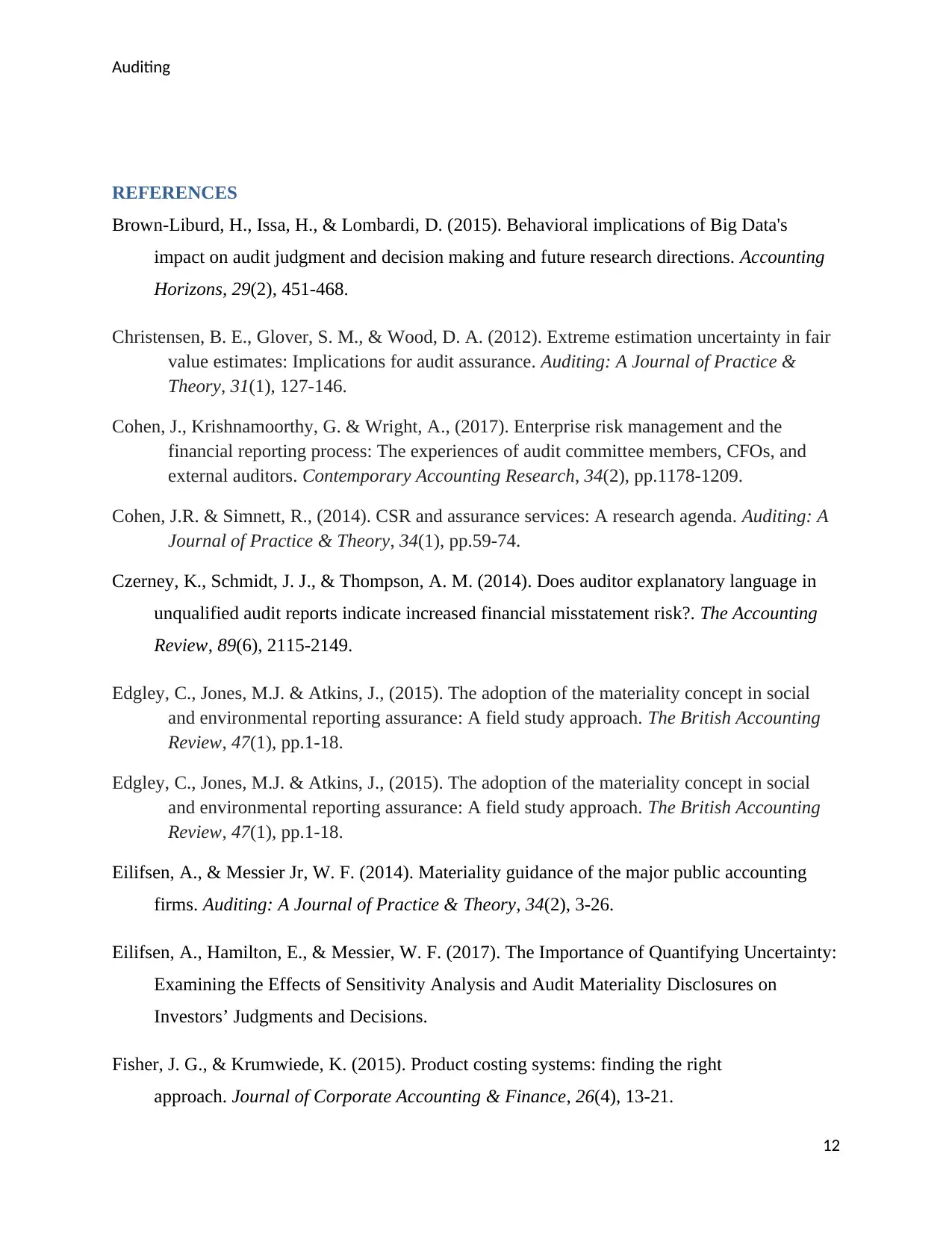
Auditing
REFERENCES
Brown-Liburd, H., Issa, H., & Lombardi, D. (2015). Behavioral implications of Big Data's
impact on audit judgment and decision making and future research directions. Accounting
Horizons, 29(2), 451-468.
Christensen, B. E., Glover, S. M., & Wood, D. A. (2012). Extreme estimation uncertainty in fair
value estimates: Implications for audit assurance. Auditing: A Journal of Practice &
Theory, 31(1), 127-146.
Cohen, J., Krishnamoorthy, G. & Wright, A., (2017). Enterprise risk management and the
financial reporting process: The experiences of audit committee members, CFOs, and
external auditors. Contemporary Accounting Research, 34(2), pp.1178-1209.
Cohen, J.R. & Simnett, R., (2014). CSR and assurance services: A research agenda. Auditing: A
Journal of Practice & Theory, 34(1), pp.59-74.
Czerney, K., Schmidt, J. J., & Thompson, A. M. (2014). Does auditor explanatory language in
unqualified audit reports indicate increased financial misstatement risk?. The Accounting
Review, 89(6), 2115-2149.
Edgley, C., Jones, M.J. & Atkins, J., (2015). The adoption of the materiality concept in social
and environmental reporting assurance: A field study approach. The British Accounting
Review, 47(1), pp.1-18.
Edgley, C., Jones, M.J. & Atkins, J., (2015). The adoption of the materiality concept in social
and environmental reporting assurance: A field study approach. The British Accounting
Review, 47(1), pp.1-18.
Eilifsen, A., & Messier Jr, W. F. (2014). Materiality guidance of the major public accounting
firms. Auditing: A Journal of Practice & Theory, 34(2), 3-26.
Eilifsen, A., Hamilton, E., & Messier, W. F. (2017). The Importance of Quantifying Uncertainty:
Examining the Effects of Sensitivity Analysis and Audit Materiality Disclosures on
Investors’ Judgments and Decisions.
Fisher, J. G., & Krumwiede, K. (2015). Product costing systems: finding the right
approach. Journal of Corporate Accounting & Finance, 26(4), 13-21.
12
REFERENCES
Brown-Liburd, H., Issa, H., & Lombardi, D. (2015). Behavioral implications of Big Data's
impact on audit judgment and decision making and future research directions. Accounting
Horizons, 29(2), 451-468.
Christensen, B. E., Glover, S. M., & Wood, D. A. (2012). Extreme estimation uncertainty in fair
value estimates: Implications for audit assurance. Auditing: A Journal of Practice &
Theory, 31(1), 127-146.
Cohen, J., Krishnamoorthy, G. & Wright, A., (2017). Enterprise risk management and the
financial reporting process: The experiences of audit committee members, CFOs, and
external auditors. Contemporary Accounting Research, 34(2), pp.1178-1209.
Cohen, J.R. & Simnett, R., (2014). CSR and assurance services: A research agenda. Auditing: A
Journal of Practice & Theory, 34(1), pp.59-74.
Czerney, K., Schmidt, J. J., & Thompson, A. M. (2014). Does auditor explanatory language in
unqualified audit reports indicate increased financial misstatement risk?. The Accounting
Review, 89(6), 2115-2149.
Edgley, C., Jones, M.J. & Atkins, J., (2015). The adoption of the materiality concept in social
and environmental reporting assurance: A field study approach. The British Accounting
Review, 47(1), pp.1-18.
Edgley, C., Jones, M.J. & Atkins, J., (2015). The adoption of the materiality concept in social
and environmental reporting assurance: A field study approach. The British Accounting
Review, 47(1), pp.1-18.
Eilifsen, A., & Messier Jr, W. F. (2014). Materiality guidance of the major public accounting
firms. Auditing: A Journal of Practice & Theory, 34(2), 3-26.
Eilifsen, A., Hamilton, E., & Messier, W. F. (2017). The Importance of Quantifying Uncertainty:
Examining the Effects of Sensitivity Analysis and Audit Materiality Disclosures on
Investors’ Judgments and Decisions.
Fisher, J. G., & Krumwiede, K. (2015). Product costing systems: finding the right
approach. Journal of Corporate Accounting & Finance, 26(4), 13-21.
12
Paraphrase This Document
Need a fresh take? Get an instant paraphrase of this document with our AI Paraphraser
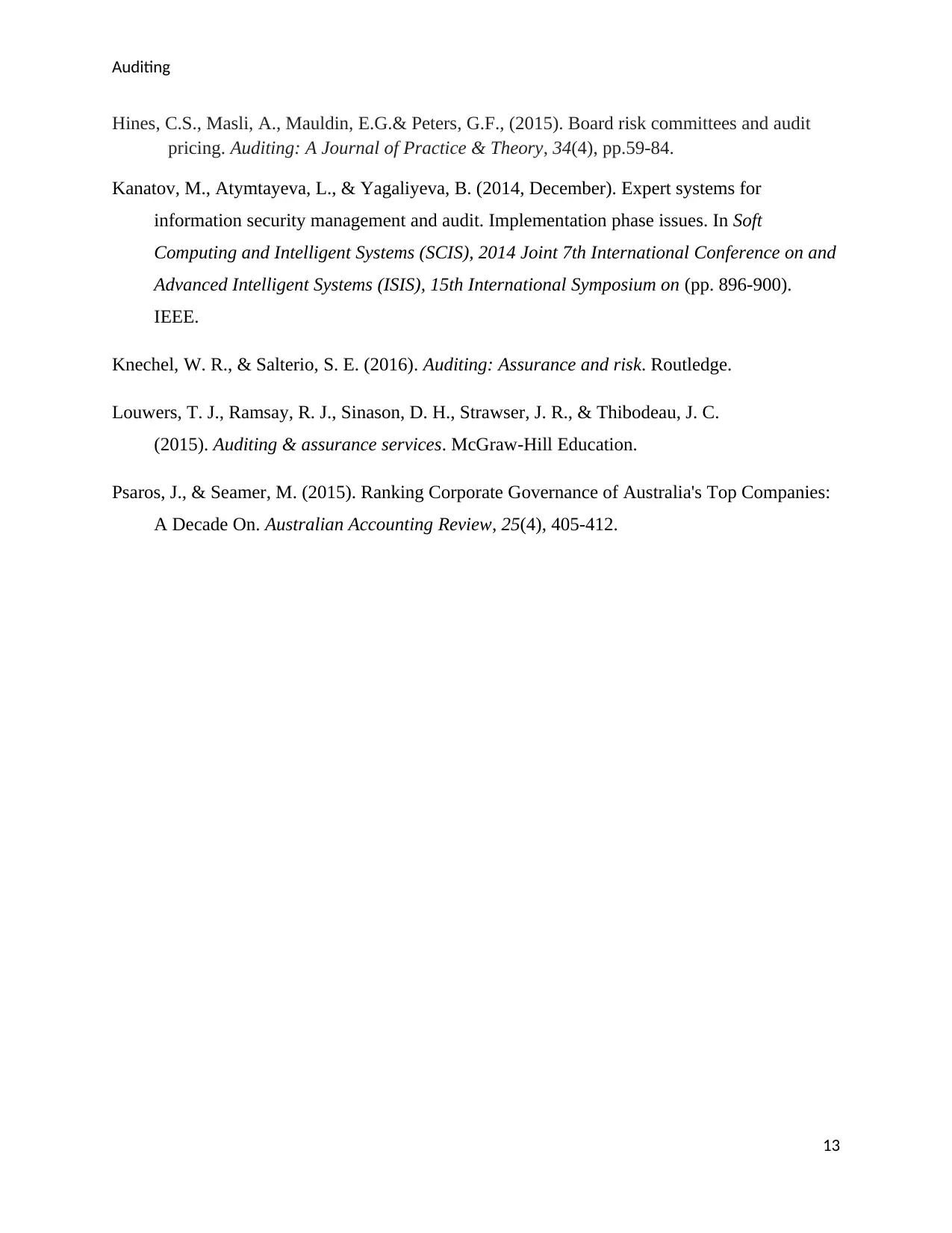
Auditing
Hines, C.S., Masli, A., Mauldin, E.G.& Peters, G.F., (2015). Board risk committees and audit
pricing. Auditing: A Journal of Practice & Theory, 34(4), pp.59-84.
Kanatov, M., Atymtayeva, L., & Yagaliyeva, B. (2014, December). Expert systems for
information security management and audit. Implementation phase issues. In Soft
Computing and Intelligent Systems (SCIS), 2014 Joint 7th International Conference on and
Advanced Intelligent Systems (ISIS), 15th International Symposium on (pp. 896-900).
IEEE.
Knechel, W. R., & Salterio, S. E. (2016). Auditing: Assurance and risk. Routledge.
Louwers, T. J., Ramsay, R. J., Sinason, D. H., Strawser, J. R., & Thibodeau, J. C.
(2015). Auditing & assurance services. McGraw-Hill Education.
Psaros, J., & Seamer, M. (2015). Ranking Corporate Governance of Australia's Top Companies:
A Decade On. Australian Accounting Review, 25(4), 405-412.
13
Hines, C.S., Masli, A., Mauldin, E.G.& Peters, G.F., (2015). Board risk committees and audit
pricing. Auditing: A Journal of Practice & Theory, 34(4), pp.59-84.
Kanatov, M., Atymtayeva, L., & Yagaliyeva, B. (2014, December). Expert systems for
information security management and audit. Implementation phase issues. In Soft
Computing and Intelligent Systems (SCIS), 2014 Joint 7th International Conference on and
Advanced Intelligent Systems (ISIS), 15th International Symposium on (pp. 896-900).
IEEE.
Knechel, W. R., & Salterio, S. E. (2016). Auditing: Assurance and risk. Routledge.
Louwers, T. J., Ramsay, R. J., Sinason, D. H., Strawser, J. R., & Thibodeau, J. C.
(2015). Auditing & assurance services. McGraw-Hill Education.
Psaros, J., & Seamer, M. (2015). Ranking Corporate Governance of Australia's Top Companies:
A Decade On. Australian Accounting Review, 25(4), 405-412.
13
1 out of 14
Related Documents
Your All-in-One AI-Powered Toolkit for Academic Success.
+13062052269
info@desklib.com
Available 24*7 on WhatsApp / Email
![[object Object]](/_next/static/media/star-bottom.7253800d.svg)
Unlock your academic potential
© 2024 | Zucol Services PVT LTD | All rights reserved.




